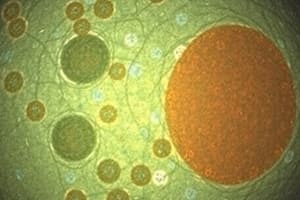Podcast
Questions and Answers
What is the ideal surface area to volume ratio for efficient cellular function?
What is the ideal surface area to volume ratio for efficient cellular function?
- 3:1 (correct)
- 4:1
- 1:1
- 2:1
Why do larger cells not exist in nature?
Why do larger cells not exist in nature?
- They cannot efficiently release waste. (correct)
- They require more nutrients than they can absorb.
- They grow too quickly and die.
- They cannot generate energy effectively.
What characteristic helps some cells overcome size limitations?
What characteristic helps some cells overcome size limitations?
- Being spherical in shape
- Having a thicker membrane
- Having multiple nuclei
- Being long and narrow (correct)
What is the minimum distance for two points to be resolved by the naked eye?
What is the minimum distance for two points to be resolved by the naked eye?
What type of microscope can resolve structures that are 0.2 nm apart?
What type of microscope can resolve structures that are 0.2 nm apart?
What is the primary limitation of light microscopes?
What is the primary limitation of light microscopes?
How does cell size affect the surface area to volume ratio?
How does cell size affect the surface area to volume ratio?
Which type of microscope uses magnifying lenses with visible light?
Which type of microscope uses magnifying lenses with visible light?
What is the primary function of the cytoskeleton in eukaryotic cells?
What is the primary function of the cytoskeleton in eukaryotic cells?
What additional structure do plant cells possess that is generally absent in animal cells?
What additional structure do plant cells possess that is generally absent in animal cells?
What are the three types of fibers that make up the eukaryotic cytoskeleton?
What are the three types of fibers that make up the eukaryotic cytoskeleton?
Which of the following statements is true regarding the similarities between animal and plant cells?
Which of the following statements is true regarding the similarities between animal and plant cells?
What is one of the functions of the large vacuoles found in plant cells?
What is one of the functions of the large vacuoles found in plant cells?
What is the primary role of microfilaments in cells?
What is the primary role of microfilaments in cells?
Which type of fiber is known to be the largest among the cytoskeletal elements?
Which type of fiber is known to be the largest among the cytoskeletal elements?
What structural arrangement do eukaryotic flagella and cilia exhibit?
What structural arrangement do eukaryotic flagella and cilia exhibit?
What is the primary function of ribosomes in a cell?
What is the primary function of ribosomes in a cell?
How is DNA organized in prokaryotic cells compared to eukaryotic cells?
How is DNA organized in prokaryotic cells compared to eukaryotic cells?
Which characteristic distinguishes intermediate filaments?
Which characteristic distinguishes intermediate filaments?
Which function does the centrosome primarily serve in animal cells?
Which function does the centrosome primarily serve in animal cells?
What components make up the plasma membrane of a cell?
What components make up the plasma membrane of a cell?
Which statement about the nuclear organization in prokaryotes is accurate?
Which statement about the nuclear organization in prokaryotes is accurate?
How do microtubules facilitate movement within cells?
How do microtubules facilitate movement within cells?
What is the cytoplasm primarily composed of?
What is the cytoplasm primarily composed of?
In which type of cells are centrioles typically found?
In which type of cells are centrioles typically found?
What is a primary feature of eukaryotic cell walls compared to prokaryotic cell walls?
What is a primary feature of eukaryotic cell walls compared to prokaryotic cell walls?
What characterizes the hydrophobic tails of phospholipids in the plasma membrane?
What characterizes the hydrophobic tails of phospholipids in the plasma membrane?
Which organelle is associated with the synthesis and processing of proteins?
Which organelle is associated with the synthesis and processing of proteins?
What type of structure do eukaryotic cells have that prokaryotic cells lack?
What type of structure do eukaryotic cells have that prokaryotic cells lack?
What feature distinguishes the cell walls of archaea from those of bacteria?
What feature distinguishes the cell walls of archaea from those of bacteria?
What is the primary purpose of a bacterial cell wall?
What is the primary purpose of a bacterial cell wall?
How do eukaryotic flagella differ from prokaryotic ones?
How do eukaryotic flagella differ from prokaryotic ones?
What roles do pili serve in bacterial cells?
What roles do pili serve in bacterial cells?
Which type of bacteria can absorb purple dye?
Which type of bacteria can absorb purple dye?
What component of bacterial cell walls may influence susceptibility to antibiotics?
What component of bacterial cell walls may influence susceptibility to antibiotics?
What is the role of capsule in bacteria?
What is the role of capsule in bacteria?
Kinesins are essential for what primary cellular function?
Kinesins are essential for what primary cellular function?
How does water affect bacterial cells regarding their cell walls?
How does water affect bacterial cells regarding their cell walls?
What aspect of archaeal membranes helps differentiate them from bacterial membranes?
What aspect of archaeal membranes helps differentiate them from bacterial membranes?
Study Notes
Surface to Volume Ratio
- A 3:1 surface area to volume ratio is considered ideal for cells.
- A larger surface area allows for efficient waste removal and nutrient intake.
- Organisms with smaller cells have an advantage because they have a higher surface area to volume ratio.
- As a cell increases in size, its volume increases faster than its surface area.
- Cells that become too large become inefficient and cannot function properly.
- Smaller cells have a larger surface area to volume ratio.
- Some cells, like neurons, overcome size limitations by being long and narrow.
Microscopes
- Most cells are too small to be seen with the naked eye, usually less than 50 micrometers in diameter.
- Resolution refers to the minimum distance two points can be apart and still be distinguished as separate.
- Objects must be at least 100 micrometers apart to be resolved by the naked eye.
Types of Microscopes
- Light microscopes:
- Use visible light and magnifying lenses.
- Can resolve structures as small as 200 nanometers apart.
- Limited by the wavelength of light.
- Electron microscopes:
- Use beams of electrons to image objects.
- Can resolve structures as small as 0.2 nanometers apart.
- Transmission electron microscopes pass electrons through the specimen.
- Scanning electron microscopes scan the surface of the specimen with electrons.
Basic Structural Similarities of Cells
- Nucleoid (Prokaryotes) or nucleus (Eukaryotes):
- Contains DNA.
- Prokaryotes:
- Lack a membrane-bound nucleus.
- DNA is circular and located in the nucleoid region.
- Eukaryotes:
- Have a membrane-bound nucleus.
- DNA is linear and organized into chromosomes.
- Cytoplasm:
- Semifluid matrix containing organelles and cytosol.
- Contains the cytoskeleton which is important for cell shape, support, and transport.
- Ribosomes:
- Synthesize proteins.
- Found freely in the cytoplasm and attached to the endoplasmic reticulum (ER).
- Plasma membrane:
- Phospholipid bilayer that surrounds the cell.
- Composed of lipids and proteins.
- Hydrophilic heads and hydrophobic tails.
Kinesin
- A motor protein that walks along microtubules to transport cargo within the cell.
Prokaryotic Cells
- Flagellum:
- Long, whip-like structure for movement.
- Pili:
- Short, hair-like structures for attachment and genetic transfer.
- Capsule:
- Outer layer that helps bacteria stick to surfaces.
Bacterial Cell Walls
- Most bacterial cells have a strong cell wall made of peptidoglycan.
- Gram-positive bacteria have a thick peptidoglycan layer and stain purple.
- Gram-negative bacteria have a thinner peptidoglycan layer and do not stain purple.
- Cell walls protect the cell, maintain its shape, and prevent excessive water uptake or loss.
- The structure of bacterial cell walls influences their susceptibility to antibiotics.
Archaean Cell Walls and Membranes
- Archaean cell walls do not contain peptidoglycan.
- They have a different lipid structure compared to bacteria.
- Most archaea are harmless to humans.
- They are often found in extreme environments like hot springs.
Flagella in Prokaryotes
- Some prokaryotic cells have flagella for movement.
- Flagella are different from eukaryotic flagella in structure and function.
Cytoskeleton (Eukaryotic Cells)
- A network of protein fibers that provides support and facilitates cell movement.
- Composed of three types of filaments:
- Microtubules: The largest filaments, function as tracks for motor proteins and play a role in cell division.
- Microfilaments (actin filaments): Involved in cell contraction, crawling, and cytokinesis.
- Intermediate filaments: Provide structural support and shape.
Animal vs Plant Cells
- Similarities:
- Both have plasma membranes.
- Both contain most of the same organelles.
- Differences:
- Plant cells have a cell wall outside the plasma membrane, large vacuoles, and chloroplasts.
- Animal cells do not have these structures
Plant Cell Walls
- Composed of cellulose.
- Provide structural support and protection.
Cytoskeleton (Eukaryotic Cells)
- Microtubules:
- Composed of α- and β-tubulin subunits.
- Support cell shape, facilitate movement of materials within the cell, and move chromosomes during cell division.
- Form the core of cilia and flagella in eukaryotic cells.
- Microfilaments (actin filaments):
- Composed of two intertwined protein chains.
- Involved in cellular movements like contraction, crawling, and pinching during cytokinesis.
- Intermediate filaments:
- Stable and provide support.
- Found in the middle size range between actin and microtubules.
Centrosomes
- Region in animal cells that surrounds centrioles.
- Function in cellular reproduction as a microtubule organizing center.
- Most animal and protist cells have centrioles, which occur in pairs.
- Plants and fungi usually lack centrioles.
Centrioles
- Small cylindrical structures composed of microtubules.
- Function in the formation of microtubules.
Cell Movement (Eukaryotic Cells)
- The movement of actin microfilaments, microtubules, or both helps cells move.
- Some cells crawl using actin microfilaments, such as amoebas.
- Muscle cells also use microfilaments for contraction.
- Eukaryotic flagella and cilia have a 9 + 2 arrangement of microtubules:
- 9 pairs of microtubules surround 2 central microtubules.
- Cilia are shorter and more numerous than flagella.
Eukaryotic Cell Walls
- Present in plants, fungi, and some protists.
- Distinct from prokaryotic cell walls chemically and structurally.
- Plant and protist cell walls are made of cellulose.
Studying That Suits You
Use AI to generate personalized quizzes and flashcards to suit your learning preferences.
Related Documents
Description
This quiz covers important concepts related to the surface area to volume ratio in cells, explaining why a higher ratio is advantageous for cellular efficiency. Additionally, it highlights the limitations imposed by cell size and introduces various types of microscopes used to visualize cells. Test your knowledge on these foundational biological principles.




